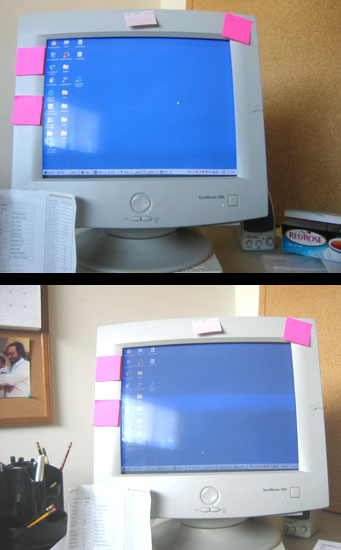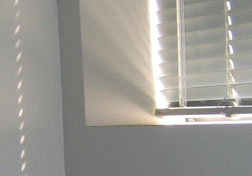Everybody's heard of armchair scientists, but how about desk-chair scientists? That's right — you can study scientific phenomena even when you're supposed to be working.

Glare on my computer screen is much worse at 2 p.m. (bottom) than at 8:30 a.m.
Tony Flanders
Sky & Tel's recent office move was a great blessing for me because I switched from an interior cubicle to a window office. But every silver lining has its cloud. The downside of being able to see and hear the outdoors is that I have to close the blinds in the early afternoon, because the glare on my computer screen becomes intolerable when the Sun is on my side of the building.
It took me a while to realize that my computer screen was serving as an informal sky-brightness meter. The glare comes from scattered light; direct sunlight is only a problem in mid-winter, when the Sun is low. What I experience every day is the fact that the sky is many times brighter near the Sun — and particularly below the Sun — than it is on the opposite side of the sky. In fact, the change is so dramatic that it overwhelms the considerable difference between a transparent blue sky, haze, and solid clouds.
This is precisely the same effect that I had gone to great pains to measure with respect to the Moon a few months ago. And I could have done it all without budging from my office just by taking a few digital photos at different times of day!

Venetian blinds produce multiple pinhole-camera images of the Sun.
Tony Flanders
This put me in mind of an experience I had many years earlier, when I worked as a computer programmer rather than an editor. A partial solar eclipse was taking place, and I'd gone into my boss's office to offer him a view through my telescope. While I was there, I took a close look at the little line of dots where the Sun was shining through the holes in his Venetian blinds. I realized that instead of being perfect ellipses as usual, each one had a black cavity on one side. I felt simultaneously pleased to be able to show the eclipse to my boss without a telescope and foolish for never having realized before that these everyday dots are in fact pinhole-camera images of the Sun.
I wonder if really big sunspots show up on these everyday Sun images?
 3
3
Comments
Tony Flanders
July 26, 2007 at 1:32 pm
Re eclipses... and further, noting the sun shining through a thick canopy of leaves yields mutiple images on the ground.
Or, maybe that is too obvious...
- Ernest Freeman
-------------------------
Tony answers: Obvious only in retrospect. The first time I noticed that was when I drove up to New Hampshire with my wife to view an annular eclipse some years ago. We hiked to an open mountaintop well in advance, viewed the eclipse, and started to hike down just after the annular phase had ended. It's only when we reentered the trees that I noticed all those lovely crescent circles on the ground, and I had that "why did this never occur to me before" moment.
You must be logged in to post a comment.
Tony Flanders
July 26, 2007 at 1:33 pm
If the sun is glaring on your tv screen, why don't you move your desk around.
Interesting article, enjoyed it very much!
Starr of :
http://asktheastronomer.blogspot.com
--------
Tony answers: Other spots in the office have even more glare — or have other, unrelated problems. All in all, this is a pretty good compromise.
You must be logged in to post a comment.
Jacques Millet
July 26, 2007 at 1:35 pm
Dear Tony,
I experienced a bit with images of the sun through pinholes to find the optimum size for different "focal" length. Too small and you loose sharpness by diffraction, too big, well, a 5mm hole can't make an image sharper than 5mm.
I found that the longer the focal length, the bigger was the ratio: lenght/aperture. I took the whole length of my apartment (diagonally) about 8 meters and found that the best aperture was about 5mm. That day, (feb 10 1980) there was a big sunspot in the center of the sun that was visible with the naked eye (filtered of course) and I wanted to see if it could be visible with a pinhole and not only was it visible but I thought I could see smaller ones on the edge. A look with the telescope confirmed that.
I long wondered what the ancient Chinese did to record naked eye sunspots. Looking at a setting sun or through a certain type of clouds didn't give many opportunities. Now I know that they had another means.
You must be logged in to post a comment.
You must be logged in to post a comment.